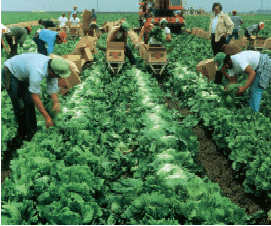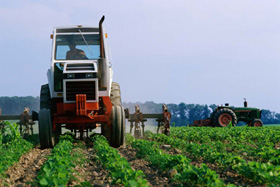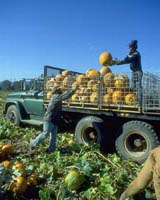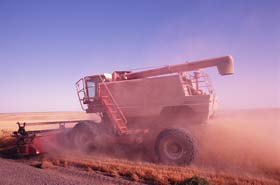Workers and Pickers
|
Do You Know... Youth agricultural
workers are exposed to a variety of environmental hazards that are
potentially harmful to their health and well-being. Farmers and farm workers
suffer from increased rates of respiratory diseases, noise-induced hearing loss,
skin disorders, certain cancers, chemical toxicity, and heat-related illnesses.
There are precautions that can be taken to minimize or eliminate the following
potential hazards workers may encounter.
|
|
|
|

|
Overexertion
is the leading accident type in most types of agribusinesses. These types of accidents (strains and
sprains) account for nearly 30 percent of all serious accidents. These are
typically lifting, pulling, pushing, and carrying-type activities.
More attention should be given to proper ways to avoid injuries when
involved in these types of activities. |
|
|
Strains and Sprains |
Potential Hazard
Repetitive prolonged reaching, bending,
and lifting can lead to back strains and sprains.
Teen Safety Solutions
Employers have the primary responsibility for
protecting the safety and health of their workers. Employees are responsible for
following the safe work practices of their employers.
|
- Maintain good back posture while working.
- Shift weight from foot to foot, when standing and bending for long
periods.
- Stand with feet shoulder-width apart, one foot slightly in front of the other.
- Keep a straight back and move down to a squatting position using leg muscles.
- Turn feet and arms to reach for objects rather than twisting your back.
- Take frequent stretch breaks to avoid overusing muscles.
- Rotate to other tasks.
- Get help to lift heavy items (over 35 pounds).
|

|
Employer Safety Solutions
Employers have the primary responsibility for
protecting the safety and health of their workers. Employees are responsible for
following the safe work practices of their employers.
- Maintain all equipment and ensure
that workers are using the right equipment for the right job.
- Provide handles on all containers.
- Provide dollies, pallet trucks, or utility carts that have to be carried more than a few feet.
- Provide roller conveyors for bags or boxes of vegetables
or chemicals that are handled often to reduce lifting
stress.
- Train all employees in work methods,
whether full-time or seasonal. Do not allow workers to
begin work without safety training.
- Train all workers, including supervisors
and foremen, in how to handle emergency
situations.
- Have supervisors closely monitor
workers as they begin each new workday to identify those who
need further training or will not be able to complete work tasks
safely.
|
|
|
Noise |
Potential Hazard
Worker exposure to high-intensity noise from working around noisy
machinery, animals, and firearms.
Teen Safety Solutions
Employers have the primary responsibility for
protecting the safety and health of their workers. Employees are responsible for
following the safe work practices of their employers.
- Use hearing protection such as earplugs
or muffs to prevent hearing
loss around noisy machinery.
- Use hearing protection from the minute noise begins.
- Limit the duration of noise exposure if you are without ear protection.
- Use the "two arm rule." If you
need to raise your voice to be heard when you are two arm
lengths from the other person, the noise level is probably high
enough that you need to protect your hearing.
- Have a hearing test if you experience ringing in your ears.
Employer Safety Solutions
Employers have the primary responsibility for
protecting the safety and health of their workers. Employees are responsible for
following the safe work practices of their employers.
- Keep machinery and equipment well-lubricated and
well-maintained. Regularly tighten all components.
- Replace defective mufflers and exhaust system parts. Do
not use a "straight pipe" exhaust for tractors or any
other engines. These pipes emit damaging sound levels for
minimal power increase.
- Reduce noise from stationary equipment by enclosing components
or building acoustic barriers or heavy partitions.
|
|
|
Chemicals |
Potential Hazard
If you are under 16 years old, Child
Labor Laws forbid you from handling certain classes and types of chemicals or
pesticides; state
laws may be even more stringent.
For more information about chemical hazards refer to the Chemicals
section.
|
Teen Safety Solutions
|
Employers have the primary responsibility for
protecting the safety and health of their workers. Employees are responsible for
following the safe work practices of their employers.
|
- Wear all provided protective clothing.
- Wash before eating, drinking, smoking, using chewing gum or tobacco, or using the toilet.
- Avoid contact with plants or chemicals to
which your are sensitive.
- Avoid touching your eyes, nose, or mouth if your hands might be contaminated with chemicals.
|

|
Employer Safety Solutions
Employers have the primary responsibility for
protecting the safety and health of their workers. Employees are responsible for
following the safe work practices of their employers.
- Train workers to be able to identify chemical poisoning.
- Develop an emergency plan and train workers in procedures to follow in case of a spill, fire, or other emergency.
|
|
|
Skin Disorders and Cancers |
Potential Hazard - Skin Cancer
Employees may become more prone to skin cancer from spending long
hours working in the sun. The back of the neck may be especially vulnerable to the rays of the sun.
Teen Safety Solutions
Employers have the primary responsibility for
protecting the safety and health of their workers. Employees are responsible for
following the safe work practices of their employers.
- Wear a sunblock that absorbs or deflects ultraviolet rays.
- Wear protective clothing such as long-sleeved shirts, pants, and wide-brimmed hats.
- Avoid overexposure to the sun, especially between 11 a.m. and 2 p.m.
- Conduct regular self-examinations for
early detection of trouble spots of skin disorders and seek medical help for problems.
Potential Hazard - Contact
Dermatitis
Contact dermatitis is a skin disorder that
occurs among agricultural workers. There are two general categories
of dermatitis:
irritant and allergic. Irritants act directly on the skin at the
place of contact. Allergic sensitizers, however, cause changes in
the immune system so that subsequent contact produces a reaction.
Other types of agricultural dermatitis include heat rash, origin
infections, and insect and plant irritants.
|
Teen Safety Solutions
|
Employers have the primary responsibility for
protecting the safety and health of their workers. Employees are responsible for
following the safe work practices of their employers.
|
- Wear protective clothing, including gloves.
- Avoid contact with plants or chemicals to
which you are sensitive.
- Be aware of the symptoms caused by contact with an irritating
substance such as:
- Fluid-filled bumps or blisters.
- Tenderness and redness of skin.
- Oozing cracks or fissures in irritated, reddened areas.
- Itching and burning.
- Seek medical attention for skin disorders.
|
 |
Employer Safety Solutions
Employers have the primary responsibility for
protecting the safety and health of their workers. Employees are responsible for
following the safe work practices of their employers.
- Encourage employees to wash frequently.
- Provide workers with PPE, such as gloves.
|
|
|
Respiratory
|
Potential Hazard
Farm work may present several respiratory hazards to
workers. Exposure to nuisance dust, moldy hay, straw, grain, as well as gases, has been linked to excessive coughing and
congestion in many workers, as well as long-term diseases such as
asthma, chronic bronchitis, Organic Dust Toxic Syndrome (ODTS), and
Farmer's Lung. For more information about respiratory hazards,
refer to the Organic Dust
section.
|
Teen Safety Solutions
|
Employers have the primary responsibility for
protecting the safety and health of their workers. Employees are responsible for
following the safe work practices of their employers.
|
- Be aware of the health effects of
breathing toxic dust. If you are involved in any of the
following areas, you may need respiratory protection against
organic dust:
- Working in dusty fields and buildings.
- Handling moldy hay.
- Working in silos or uncapping silos.
- Cleaning grain bins.
|
 |
Employer Safety Solutions
Employers have the primary responsibility for
protecting the safety and health of their workers. Employees are responsible for
following the safe work practices of their employers.
- Provide workers with respirators to
match the exposure danger in their work. There are many
types of respirators available and it is important to match the
respirator to the job. Be sure to select a respirator certified by NIOSH. Provide training and fit testing to employees using
respirators.
- Take preventative measures to minimize contamination.
|
|
|
Heat Stress
|
Potential Hazard
Dehydration (the loss of body
fluids due to perspiration) is the cause of most heat disorders. Energetic activity on hot
days can cause the body to lose one to one-and-a-half quarts of
fluid per hour. In a few hours, you could lose as much
as 6 percent of your body weight. A loss of only 2 to 3 percent of your body weight decreases blood circulation, leading to extreme discomfort and thirst, along with higher body
temperature and rapid pulse. You could then suffer from heat
cramps, dizziness, headaches, excessive sweating, and a feeling of
weakness. All of these symptoms are signs of heat exhaustion. You may suffer from heat
stroke when you lose 3 to 6 percent of your body weight and
your body stops perspiring and your temperature increases rapidly.
Convulsions, unconsciousness, and death are possible.
Teen Safety Solutions
Employers have the primary responsibility for
protecting the safety and health of their workers. Employees are responsible for
following the safe work practices of their employers.
- Wear proper protective clothing (cool, loose, and light-colored), including a wide-brimmed hat.
- Take breaks and drink plenty of water - 10 to
12 ounces every half hour.
- Do strenuous work at the coolest time of day.
- Avoid alcohol and caffeine. These make the
body lose water and increase the risk for heat illnesses.
- Know the symptoms and treatment for heat stroke, the most serious illness
caused by overheating:
- Symptoms include dry, hot, red, or spotted skin. You may experience a rapid and strong pulse, and become extremely weak and even lose
consciousness.
- Treatment includes placing the victim in a cool or shady area and fanning them to promote cooling. Remove outer clothing and
sponge the skin using cool water. Call an ambulance immediately.
Employer Safety Solutions
Employers have the primary responsibility for
protecting the safety and health of their workers. Employees are responsible for
following the safe work practices of their employers.
- Have a person certified in first aid (with knowledge of the symptoms and treatment of heat stroke) on every field work team.
- Train workers to be aware of the dangers of working in the heat
and ensure that they know who is trained in first aid.
- Require crews to take breaks and drink water, especially crews working at piece rate.
- Supply adequate water and allow reasonable opportunities to drink.
- Provide shade for workers as possible.
- Allow workers to slow the work pace or reduce the work load in hot weather, especially if they begin to feel uncomfortable.
- Move any worker who is overcome with heat to a cool area and call for immediate medical help.
|
|
|
Temporary Labor Camps and Seasonal Work |
Potential Hazard
Seasonal field workers or workers in
temporary labor camps may be exposed to poor living conditions.
Employers have the primary responsibility for
protecting the safety and health of their workers. Employees are responsible for
following the safe work practices of their employers.
Follow OSHA Standards including:
- Provide adequate facilities and grounds to house laborers in a clean
and sanitary condition, including living, sleeping quarters, food
preparation areas, and toilet facilities. [1910.142]
Temporary Labor Camps.
- Provide handwashing facilities, toilets, potable drinking water, if 11
or more field workers are employed. [1928.110]
Field Sanitation.
|
|
|
Additional Information:
-
Health Hazards in Agriculture: An emerging issue. National Ag Safety Database.
-
Farm Labor Contractor Safety and Health Guide. Department of Industrial Relations, Cal/OSHA Consultation, Education and Training Unit.
-
Knowing Your Limits Prevents Manual Labor Injuries. National Ag Safety Database.
-
Ladders, Lifting and Falls. National Ag Safety Database.
-
Muscle, Bone, and Back Injuries. National Ag Safety Database.
-
Farm Safety. U.S. Department of Labor, OSHA.
-
Hearing Protection for Farmers. National Ag Safety Database.
-
Heat Stress. National Ag Safety Database.
-
OSHA's Field Sanitation Standard. OSHA Fact Sheet 92-25 (1992), 1 page.
-
Simple Solutions: Ergonomics for Farm Workers. NIOSH.
-
Protecting Workers in Hot Environments. OSHA Fact Sheet 95-16 (1995, January 1).
- The Heat Equation. OSHA Office of Occupational Health Nursing,
3154 (English)
3155 (Spanish), 1998, PDF.
-
Outdoor Action Guide to Heat-Related Illnesses Fluid Balance. National Ag Safety Database.
|
|

